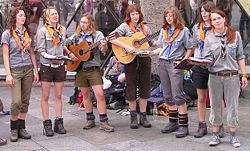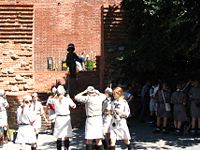Girl Guiding and Girl Scouting
2008/9 Schools Wikipedia Selection. Related subjects: Community organisations
A Girl Guide is a girl, usually ranging from 10 to 17 years of age, participating in the worldwide Scouting movement. This movement began in 1907, when Robert Baden-Powell held the first Scout camp on Brownsea Island, South England. To advance his ideas, Baden-Powell wrote the book, Scouting for Boys, which targeted boy readership, and described the Scout method of using outdoor activities to develop character, citizenship, and personal fitness qualities among youth. The girls' movement began in 1909 at The Crystal Palace in London, England, where Baden-Powell encountered a number of Girl Scouts in Scouting uniform and saw the demand for a similar programme for young women and girls.
Soon after he wrote an article called "A scheme for Girl Guides" in the Boy Scout's Gazette and asked his sister Agnes to take over leadership of the Girl Guides. In 1910 Agnes wrote How Girls can help the empire which was published in 1912.
The first Guide Company was 1st Pinkneys Green Guides (Lady Baden Powell Own), who are still going in Pinkneys Green, town of Maidenhead in the English county of Berkshire. in the UK.
Girl Guides are organised into units/troops averaging 20-30 girls under guidance of a team of leaders. Units subdivide into patrols of about six Guides and engage in outdoor and special interest activities. Units may affiliate with national and international organisations. Some Units, especially in Europe, have been co-educational since the 1970s, allowing boys and girls to work together as Scouts. There are other programme sections for older and younger girls.
The term Girl Scout is used in the United States and several East Asian countries. The two terms are used synonymously within this article.
Activities
Unit affiliation
Local groups, called variously units, companies or troops are the fundamental unit of the Girl Guides. These are run by an adult, normally a woman who is between 18 and 65 years of age. She has responsibility for the girls in her group and plans out activities for the girls as well as leading the meetings. These leaders are supported by assistants. Meetings are held anywhere from weekly to monthly depending on the commitments of the participants and the activities in progress.
Uniforms
Individual national or other emblems may be found on the individual country's Scouting article.
Uniform is a specific characteristic of Scouting. Robert Baden-Powell, at the 1938 World Jamboree, said it "hides all differences of social standing in a country and makes for equality; but, more important still, it covers differences of country and race and creed, and makes all feel that they are members with one another of the one great brotherhood".
In the 1909 The Scheme for Girl Guides, the uniform for the newly emerging movement was given as:
Jersey of company colour. Neckerchief of company colour. Skirt, knickers, stockings, dark blue. Cap - red biretta, or in summer, large straw hat. Haversack, cooking billy, lanyard and knife, walking stick or light staff. Cape, hooked up on the back. Shoulder knot, of the 'Group' colour on the left shoulder. Badges, much the same as the Boy Scouts. Officers wear ordinary country walking-dress, with biretta of dark blue, white shoulder knot, walking stick, and whistle on lanyard.
Guide uniform varies widely within cultures, climates and the activities undertaken and has frequently changed through history. They are often adorned with badges indicating a Guide's achievements and responsibilities. Uniforms within each organisation are often different for each age group. Brownies often wear brown clothing. In some places, uniforms are manufactured and distributed by approved companies and the local Guiding organisation. In other places, members make uniforms themselves.

